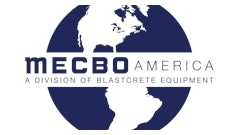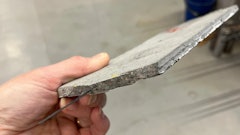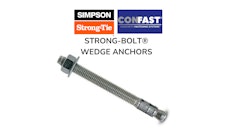
Pervious concrete. No doubt you've heard of it and its "green" possibilities. But how much do you know about pervious concrete and its presence in today's concrete industry?
Pervious concrete is similar to conventional concrete but manufactured without most or all of the sand in order to create voids allowing water to flow through the concrete and drain through the subgrade for filtration, ground water recharge and reduction in overall stormwater runoff, says Dan Huffman, vice president of national resources for the National Ready Mixed Concrete Association (NRMCA). Pervious concrete has been in limited use in Europe for over 100 years but took hold in the United States about 30 years ago, Huffman adds.
Pervious concrete started in Florida on small projects but since then has spread across the states and applications have grown in size. Pervious concrete has gone from "experimental" projects to larger installations, say Scott Erickson of Evolution Paving Resources, a company in Salem, Ore., that is dedicated to improving the quality of pervious concrete.
"Five or 10 years ago we were talking driveways and sidewalks. Now, while those are still happening all over the place, we're also talking large commercial and multi-acre facilities with pervious concrete," Huffman adds.
The need for pervious has also grown, and today the proper use of pervious concrete is among the recommended Best Management Practices (BMPs) of the US Environmental Protection Agency (EPA) for compliance with federal stormwater law requirements and is otherwise accepted for use by many local stormwater management agencies across the country. Pervious allows for increased site optimization because in most cases its use should totally limit the need for detention and retention ponds, swales and other more traditional stormwater management devices that are otherwise required for compliance with federal stormwater regulations on commercial sites of one acre or more, Huffman says.
Even with pervious installations growing in size and number, pervious concrete hasn't reached its potential. "We still don't see it as 'mainstream.' It's definitely growing and spreading but we still have a long way to go," says Dale Fisher, CEO of PCI Systems, LLC in Woodstock, Ga., and one of only four contractors nationwide to attain the NRMCA designation as a pervious "craftsman." Fisher started installing pervious concrete in the mid-1980s and formed an exclusively pervious company in the late 1990s. He has been involved in pervious long enough to see it grow, but he also notes that in some areas it hasn't advanced at all.
One major problem hurting pervious concrete is an abundance of incorrect pervious mix design specs online, says Erickson, who works in pervious research and development for Evolution Paving Resources. He points out that incorrectly designed mixes, improperly installed or improperly cured pervious concrete are the most likely reasons for defects and failure.
But the concrete industry is working to prevent these failures and provide correct specs. ACI 522 Pervious Specification was created as a standard for pervious concrete, and these specs are always being updated as the industry learns more, Erickson says. Another plus: most good specifications now require training and certification of pervious installers so more people are taking the time to become trained and certified in pervious concrete and its installation.
The mix design
As pervious concrete has evolved in the concrete industry so has its mix design. There has been a tendency to create pervious mix designs using round pea gravel that is 3/8 inch or larger, says Huffman. However, he is seeing a trend toward aggregates smaller than 3/8 inch and the use of crushed angular material in many markets.
These finer aggregates create a less coarse looking concrete and require less maintenance, adds Erickson. But contractors using a mix design with smaller aggregate need to consider where the concrete is being placed because finer aggregate does not provide the same strength performance as the coarser aggregate, he says. For example, a finer aggregate may work well for a pervious sidewalk but might not hold up as well in a heavily traveled parking lot.
Like Huffman, Erickson is seeing a move toward crushed rock instead of round for the mix designs' aggregate in the Pacific Northwest. "In my experience, round rock isn't as durable and often has less voids than crushed," Erickson says. "Round rocks can make a decent pervious, but I prefer crushed rock because it allows for more flexibility with mix designs and it looks more like traditional pavement."
As knowledge of pervious concrete has increased so has the mind-set of what a good mix design should be. For example, Fisher says people are beginning to realize that a wetter pervious mix is better than a drier mix because the wetter mix offers more working control and a longer working time. "Control comes not only with the gradation of stone but with plenty of moisture for good hydration," he says.
Admixtures, like hydration stabilizers, allow contractors more time to work with the concrete, while viscosity modifiers allow higher water-to-cement ratios for proper curing. This can be especially helpful for contractors who have less experience working with pervious concrete.
The equipment
Mix designs aren't the only aspects of pervious concrete to advance as it grows in the concrete industry. Pervious concrete installations require screeding to grade, compaction and smoothness. The equipment selection for this task has also improved over the years.
"In the 'old days' pervious concrete was handled like regular concrete. It was placed with a 2 x 4 or a truss screed and then rolled with random shop-made tools," Fisher says. Around the late 1990s, standard tools were being manufactured specifically for pervious concrete, he adds. Contractors progressed from truss screeds to roller screeds and laser screeds. Many of the spinning screeds currently available can now operate in forward and reverse, making it easier to fix any blemishes or low spots during a pervious installation, Erickson says.
But a screed isn't the only necessary tool when placing pervious concrete. After the pervious is poured from the ready mix trucks it is usually hand raked into place. After that the screeding - whether with a roller or truss screed - is done. Oftentimes crew members using hand trowels compact the edges and any slight bumps. Then they use specially designed tools to create control joints and cross roll the pavement. Pervious concrete is covered with plastic for curing, which can be done before or after cross rolling takes place, Huffman says.
Another piece of equipment gaining interest in the market is slip form pavers designed specifically for pervious concrete installations. The number of manufacturers of pervious slip form pavers and laser screeds is increasing as well, Huffman says.
Quieting the skeptics
Possibly the biggest question among pervious' critics is how it performs in freeze/thaw environments. "When pervious concrete is designed, produced, placed and maintained according to industry guidelines and standards it has a good record of performance in freeze/thaw environments," Huffman says.
Over the years there has been research as well as documented success stories of pervious in these freeze/thaw environments in areas such as Illinois and Iowa. Part of the reason pervious can be successful in cold climates is that it is designed with a retention layer of course aggregate (usually #57 stone) immediately beneath the pavement. This aggregate allows for rapid flow of moisture through the system so the pervious concrete does not become totally saturated with water, Huffman says.
Still, even with solid research and success stories of pervious in freeze/thaw environments, Fisher says skepticism has not been completely eliminated. "No one study seems to quell skepticism. Even when pervious has been proven in a similar environment in a different state people want to know how it works where they are," he says.
The future of pervious
Pervious concrete's presence in the concrete industry is going to continue to grow. Factors such as the Green Building movement, the Clean Water Act, and the rising price and changes in the asphalt industry will help push its growth, Erickson says. In fact, he believes pervious concrete will eventually become the pavement of choice.
"It's the technology that many people believe has the best chance to expand the market for concrete on a national basis," Huffman adds.
Erickson and Fisher agree that the greatest market potential for pervious is parking lots. Fisher also sees a future for pervious concrete as a structural drainage fill behind retaining walls. Pervious has also been used in building sound walls, and Fisher says we may see in increase here as well. A pervious sound wall absorbs sounds like traditional concrete but offers a lighter concrete mix than regular concrete.
Pervious concrete is the brightest star in the Green Building movement, according to Huffman, and he sees potential for the future. Pervious can help earn a project LEED credits, and Huffman believes that will influence the commercial sector as well as federally funded government projects.
But possibly the biggest potential for pervious concrete is its ability to influence the current concrete market. "It could really jump start our hurting industry right now. If we can get some paving we can really grow our market. We have a great opportunity and need to take advantage of it," Erickson says.
Now is the time to get involved in pervious concrete. Take the time now, when you have it, to educate yourself so you'll be prepared when the industry is back in full swing.





























